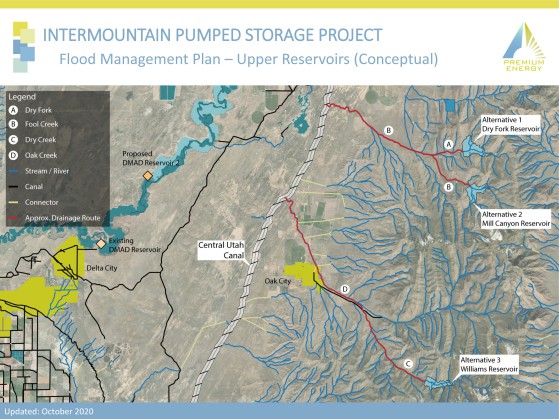IPSP - Intermountain Pump Storage Project
by Premium Energy Holdings, LLC
Engineering by PowerTech Engineer, Inc. & WAPCOS Ltd.

Background
On December 18, 2019, the FERC issued the preliminary permit to Premium Energy Holdings, LLC (PEH), for a period effective the first day of the month in which this permit is issued (December 1, 2019). The purpose of a preliminary permit is to preserve the right of the permit holder to have the first priority in applying to a license for the Project under the Federal Power Act, allowing Premium Energy Holdings to conduct investigations and secure necessary data to determine the feasibility of the Project and to prepare a license application.
About the Project
The Intermountain Project will be located northeast of Delta City within Millard County, Utah. The project is a proposed 2000-megawatt (MW) pumped storage project that would use a proposed DMAD 2 Reservoir as the lower reservoir, one mile upstream of the existing DMAD Reservoir. The proposed upper reservoir, could be any of the three proposed, located east of the project in the Canyon Mountains Range.
Documents
PEH Licensing Documents
Premium Energy Holdings, LLC will be developing and publishing a variety of documents throughout the licensing process. The following documents are associated with the Integrated Licensing Process (ILP):
- Preliminary Permit Application
- Notice of Intent (NOI)
- Pre-Application Document (PAD)
- PAD - Appendices
FERC Licensing Documents
The Federal Energy Regulatory Commission (FERC) will issue documents related to the Intermountain Pumped Storage Project licensing. The documents will be available when issued.
Studies
ENVIRONMENTAL STUDIES
- Aquatic species
- Water volume and quality
- Vegetation
- Noise impact
- Gas emissions
- Land use
- Recreational uses
- Economical analysis
- Tribal presence
- Energy supply benefit to the state
Staff
- Director: Victor Rojas
- Engineering: PTE Inc. / WAPCOS Ltd.
- Regulatory Representative: Maria Hernandez
- Media Public Affairs Representative: Vicki Rojas
- Land Representative: Bruce Hammer
- Government Affairs Representative: Rod Clark
- Environmental Representative: Bruce Hammer
- Stakeholders Outreach Representative: John Dennis
FAQ
What is Pumped-Storage Hydropower?
Please, check out this video provided by the U.S. Department of Energy, What is Pumped-Storage Hydropower.
Currently, Pumped-Storage accounts for around 95% of all utility-scale energy storage in the U.S. However, as stated by the Energy Information Administration (EIA), most of the PS Generator were built in the 1970s. Also, the ever-increasing energy demand challenges electric utilities and investors to keep pace by developing long-term projects that may help to cover the electric demand. Pumping-Storage, besides provinding energy supply, it also provides reliability to the grid.
Closed-loop pumped storage projects have a lower and upper reservoir, which are not connected to any other body water (such as a river). The same water is repeatedly used in the charging and discharging process.
Open-loop pumped storage projects are connected to a ongoing stream of water, which is used in the charge/discharge process to store and deliver energy. The storage capacity depends on the water available in the natural water feature.
In general, Closed-loop projects have less impact on aquatic resources. These impacts are primarily related to the initial reservoir filling process.
Energy Storage consists on collecting electrical energy when there is an excess of generation, and deliver it to the grid later.
The most common large-scale energy storage is pumped storage, which can be used to replace thermal generation, substitute the need of spinning reserve, or increase reliability and stability of the grid.
It is also used to store energy from intermitent renewable energy sources, such as solar or wind farms.
Pumped-storage facilities can help meeting greenhouse gas emissions reduction targets and build clean renewable energy capacity. In addition, these plants can enhance the reliability and stability of the grid.
Is Pumped-Storage safe?
Any storage solution must comply with safety requirements in order to be sustainable. The main risk related to pumped storage facilities is dam safety. If it occurs, dam failure can affect downstream communities and the environment. Nevertheless, pumped hydro technology is mature, dam risks are generally well understood and managed, and the frequency of dam safety events is very low.
What is the lifespan of a Pumped-Storage project?
Pumped-Storage Hydro is a proven technology and has a typical lifespan well over 50 years, and is the most cost-effective solution for large-scale energy storage, compared to batteries, which currently last between 8 and 15 years.
Premium Energy Holdings, LLC appreciates the presence of everyone who attended our Open House. We are open to the public for any questions or inquiries.
A copy of the PAD, and related official documents are available for review in the "Documents" section, or on the FERC's website at:
https://elibrary.ferc.gov/eLibrary/search, using docket number: P-14993.
For further information or if you would like to submit questions, please contact Maria Hernandez at
(909)595-5314 or at maria.hernandez@pehll.com
Project Insight
Details of the project are publicly presented. If you live nearby the proposed location or you are just interested in what has been presented and have any feedback or questions we would gladly receive it.
Download the presentation HERE.
Contact us at:
info@premiumenergyholdings.com
info@pehllc.com
Virtual Open House: Intermountain Pumped Storage. Delta City, UT
Expected Timeline
Preliminary Permit Application
2019
2020-2022
Pre-Filing Process
Post-Filling Process
2022-2024
2025
Engineering and Procurement
Project Construction
2025-2027
2028
Commisioning
SUBSCRIBE
STAY UPDATED ABOUT ANY NEWS ON THIS PROJECT BY EMAIL
Receive information on the progress of the project, future meetings, and answers to any question you may have.









